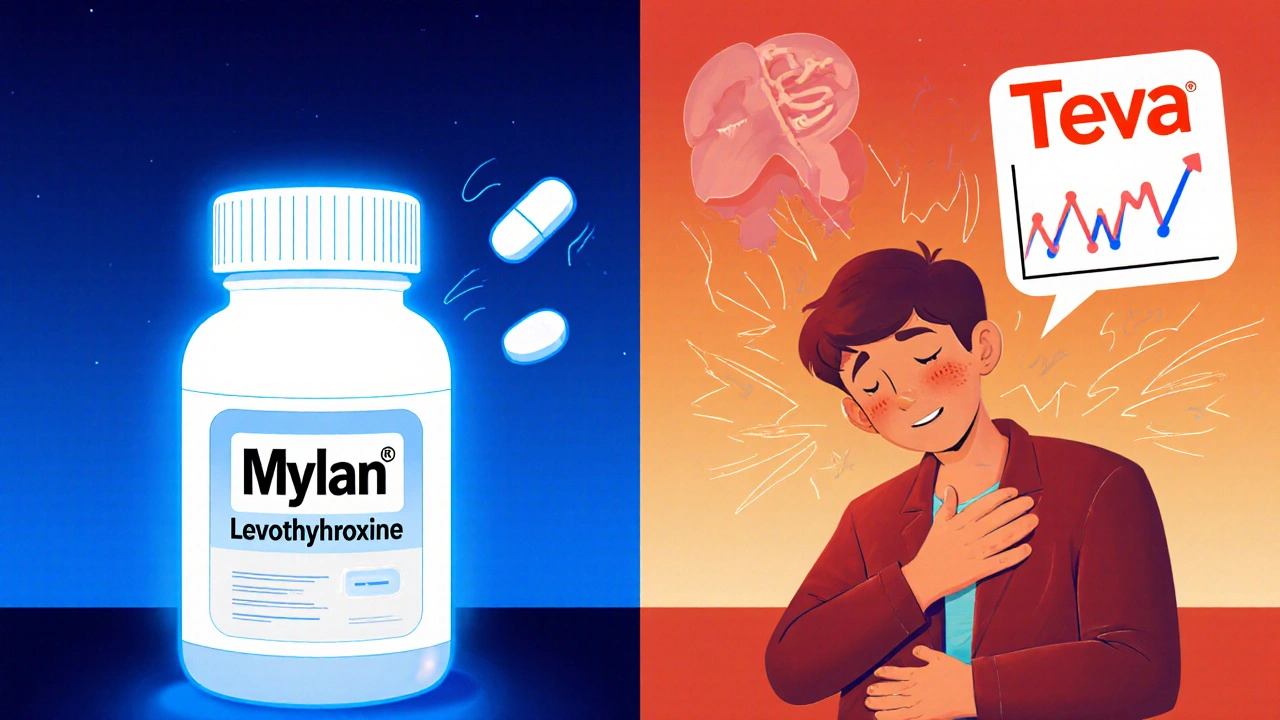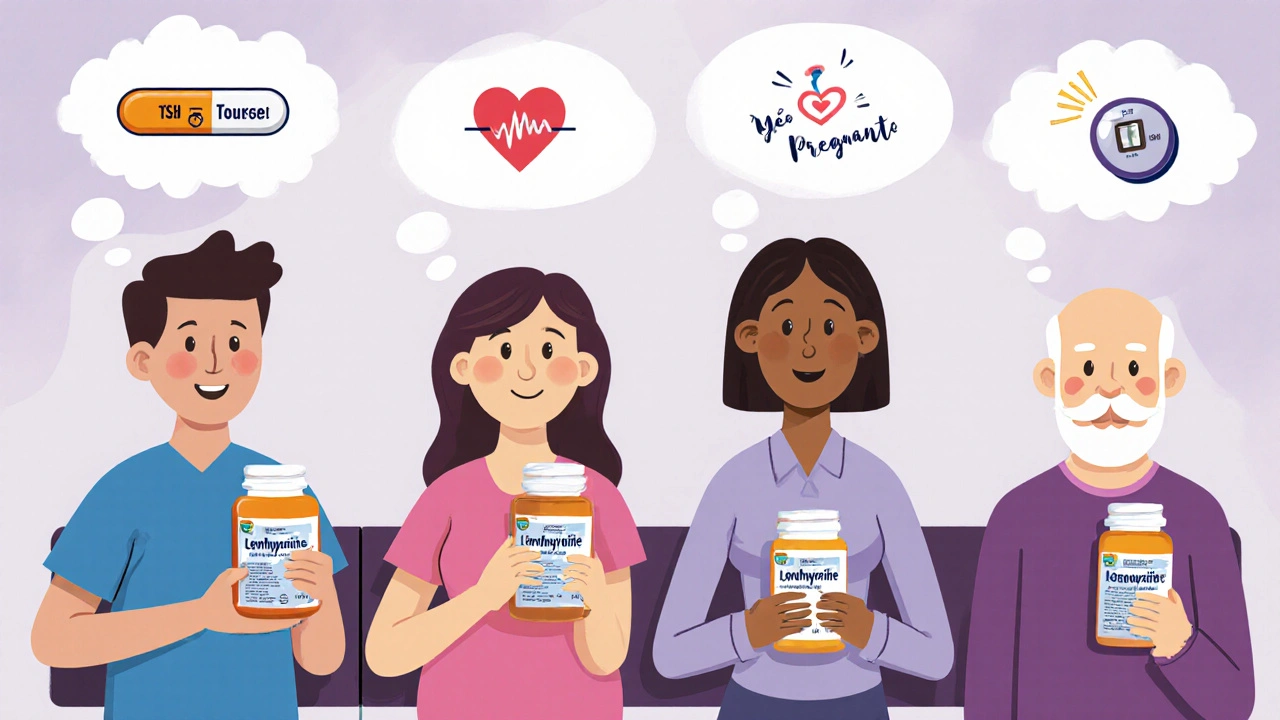
Switching between different brands of levothyroxine generics isn’t just a pharmacy decision-it can affect how you feel every day. For millions of people taking thyroid hormone replacement, even small changes in medication can trigger fatigue, weight shifts, or heart palpitations. The big question? Do you need a TSH blood test every time you get a different generic pill? The answer isn’t as simple as yes or no, and it depends on who you are, not just what the label says.
Why Levothyroxine Is Different
Levothyroxine isn’t like taking an ibuprofen or an antibiotic. It’s a narrow therapeutic index (NTI) drug, meaning tiny changes in your blood levels can cause big effects. Too little, and you’re tired, cold, and gaining weight. Too much, and your heart races, you lose weight without trying, or worse-risk bone loss or heart problems. The goal? Keep your TSH (thyroid-stimulating hormone) between 0.4 and 4.0 mIU/L. For older adults, up to 6.0 is often fine. But staying in that sweet spot matters.The FDA says all approved generic levothyroxine products are interchangeable. They require manufacturers to prove their version delivers 80-125% of the active ingredient compared to the brand-name version. That’s the standard for most drugs. But for NTI drugs like levothyroxine, some experts argue that range is too wide. A 25% variation might sound small, but in thyroid hormone, it’s enough to push someone out of their ideal range.
What the Studies Say
In 2022, a massive study of over 15,000 patients published in JAMA Internal Medicine found no meaningful difference in TSH levels between people who switched generics and those who didn’t. The average TSH was 2.7 mIU/L in both groups. That’s a strong signal that for most people, switching doesn’t break their thyroid control. But here’s the twist: another study from the Netherlands found that patients on higher doses-over 100 mcg daily-were far more likely to have abnormal TSH after switching. Sixty-three percent of switchers had TSH levels outside the target range, compared to just 24% of those who stayed on the same product. And then there’s real-world patient experience. In the UK, the Medicines and Healthcare products Regulatory Agency (MHRA) collected over 1,200 reports of symptoms after switching levothyroxine brands. Fatigue was the most common, followed by palpitations and weight changes. On Reddit’s r/Hashimotos forum, people shared stories of TSH jumping from 1.8 to 7.2 after switching from Mylan to Teva. Others said they’d switched three times in two years with zero issues.So who’s right? Both sides are. The data shows most people (around 88-92%) handle switches just fine. But for a small group-maybe 8-12%-the change triggers real problems. The challenge is knowing who falls into which group before the switch happens.
Who Needs a TSH Test After Switching?
You don’t need a TSH test after every switch if you’re healthy and stable. But if any of these apply to you, get tested 6-8 weeks after changing products:- You have thyroid cancer and are on suppressive therapy (TSH target below 0.1)
- You’re pregnant or planning to be
- You have heart disease, especially if you’re over 65
- You’ve had unstable TSH levels in the past-fluctuating between high and low
- You’ve had symptoms after switching before
- You take more than 100 mcg daily
These are the people who are most vulnerable. For them, even a 5% difference in absorption can throw off their entire balance. The UK’s NHS and the American College of Endocrinology both recommend monitoring for these groups. The Veterans Health Administration even requires it by policy.

What About the Rest of Us?
If you’re healthy, stable, and taking a standard dose (like 50-100 mcg), you probably don’t need extra testing. Routine annual TSH checks are enough. Many large health systems, including Kaiser Permanente, have stopped routine post-switch monitoring for low-risk patients because the data shows no benefit.That doesn’t mean ignore your body. If you start feeling off-more tired than usual, heart racing, unexplained weight gain or loss-don’t wait for your next appointment. Ask for a TSH test. Symptoms matter more than policy.
Why Do Some People React and Others Don’t?
Scientists are still figuring this out, but early clues point to biological differences:- Genetics: Some people have variants in the DIO2 gene, which affects how their body converts T4 to active T3. About 0.8% of the population has this.
- Excipient sensitivity: Generic versions use different fillers and binders. A small number of people react to lactose, cornstarch, or dyes in one brand but not another.
- Thyroid reserve: If your thyroid was destroyed by surgery or radiation, you have zero backup. Any variation in absorption hits harder.
- Thyroid receptor function: Some people’s cells respond less efficiently to thyroid hormone, making them more sensitive to dose changes.
Right now, we can’t test for most of these easily. But if you’ve had a bad reaction before, your body is telling you something. Keep the same product. Don’t let cost override how you feel.
What’s Changing in Guidelines
The American Thyroid Association is updating its 2014 guidelines, which told doctors to always retest after a switch. The new draft, expected in late 2024, will likely say: “Routine monitoring is not needed for most patients.” That’s a big shift.The FDA updated its labeling in January 2024 to reflect this new thinking: “For most patients, switching between different levothyroxine products does not require additional TSH monitoring beyond routine follow-up.”
But Europe’s stance is still more cautious. The European Medicines Agency still recommends testing 6-8 weeks after any switch. So if you’re traveling or on a prescription from abroad, don’t assume the rules are the same.
Practical Tips for Patients
- Ask your pharmacist: “Is this the same brand as last time?” If it’s not, make a note. Write down the name of the manufacturer (e.g., Mylan, Teva, Sandoz).
- If you’re stable and feel fine, stick with the same generic. Don’t let your pharmacy switch you without telling you.
- If you’ve had symptoms after a switch before, ask your doctor to prescribe “do not substitute” on your prescription. It’s legal and common.
- Don’t panic if you switch and feel fine. Most people don’t notice a thing.
- If you feel worse after switching, get your TSH checked. Don’t wait. Symptoms are your best guide.
Cost vs. Safety
Brand-name Synthroid costs about $45 for 90 tablets of 100 mcg. The generic? Around $4.37. That’s a 90% savings. Generic substitution saves the U.S. healthcare system over $2 billion a year. That’s huge.But if you’re one of the 8-12% who react to switches, that savings comes at a cost: extra doctor visits, unnecessary stress, and maybe even hospital visits if your TSH goes too high or low. For those people, paying a little more for consistency makes sense.
There’s no shame in asking for the same brand. If your insurance won’t cover it, ask your doctor to write a letter of medical necessity. Many insurers approve it if you’ve had documented issues.
Final Takeaway
Switching levothyroxine generics is safe for most people. The science backs it. But for some, it’s not. Your body knows when something’s off. Don’t ignore it. If you’re stable and feel good, you probably don’t need extra tests. If you’ve ever felt worse after a switch-or you’re in a high-risk group-get your TSH checked 6 weeks after any change. And if you’re one of the people who reacts? Stick with the same product. Your health isn’t a cost-saving experiment.Do I need a TSH test every time I switch generic levothyroxine brands?
No, not for most people. If you’re healthy, stable, and taking a standard dose (like 50-100 mcg), routine TSH monitoring after a switch isn’t necessary. But if you have thyroid cancer, heart disease, are pregnant, have had unstable TSH before, or take more than 100 mcg daily, get tested 6-8 weeks after switching. Always get checked if you feel worse-fatigue, palpitations, or weight changes aren’t normal.
Why do some people have problems switching generics but others don’t?
It comes down to biology. A small group of people-around 8-12%-have genetic differences, like variants in the DIO2 gene, that affect how they convert T4 to active T3. Others may react to inactive ingredients (excipients) like lactose or dyes in one brand but not another. People with no thyroid reserve (after surgery or radiation) are also more sensitive. For most, the body adjusts fine. For these sensitive individuals, even tiny absorption changes can throw off their balance.
Can I ask my doctor to prescribe a specific brand of levothyroxine?
Yes. You can ask your doctor to write “do not substitute” or “dispense as written” on your prescription. Many insurers will cover the brand-name version if you’ve had documented symptoms after switching generics. This is especially common for people with thyroid cancer, heart conditions, or those who’ve had bad reactions before. It’s a legal and reasonable request.
Are all generic levothyroxine products the same?
They’re all FDA-approved and meet the same bioequivalence standards (80-125% of the reference drug). But they’re not identical. Different manufacturers use different fillers, binders, and manufacturing processes. That’s why some people react to one brand but not another. The active ingredient is the same, but how your body absorbs it can vary slightly-enough to matter for sensitive individuals.
How long after switching should I get my TSH checked?
Wait 6-8 weeks. Thyroid hormone levels take time to stabilize after a change in medication. Testing too soon (like after 2 weeks) won’t show the full effect. That’s why guidelines recommend waiting at least 6 weeks before rechecking TSH. If you’re symptomatic, don’t wait-get tested sooner.
Is it safe to switch back and forth between generics?
It’s not recommended. Each switch carries a small risk of TSH fluctuation. If you’ve had a bad reaction once, switching again increases the chance of symptoms returning. For most people, occasional switches are fine. But if you’re sensitive, consistency matters. Try to stick with one brand unless you’re told otherwise by your doctor.
9 Comments
kshitij pandey
November 13 2025
Great post! I am from India and we use generics every day. My mom takes levothyroxine and she never had issue. But I learned something new-some people are sensitive to fillers. Maybe we need more awareness here too. Keep sharing such useful info!
Brittany C
November 13 2025
Interesting that the FDA’s 80–125% bioequivalence range is considered acceptable for NTI drugs. Clinically, that’s a 45% window-wild when you consider T4’s half-life and receptor affinity. The variance in excipients is the real wildcard, especially with lactose-sensitive patients. Not all generics are created equal, even if the label says they are.
Ryan Anderson
November 15 2025
My TSH went from 2.1 to 5.9 after a pharmacy switch. I didn’t say anything for weeks because I thought I was just ‘getting older.’ Then I read this and got tested. 🤯 Turns out I’m one of the 8-12%. Now I have a note on my script: DO NOT SUBSTITUTE. 🙌 Thank you for validating what so many of us feel but get dismissed for.
Eleanora Keene
November 16 2025
So many people think thyroid meds are like aspirin. They’re not. I’ve been on levothyroxine for 12 years. I’ve switched brands four times. Twice I felt like I was drowning in slow motion. Fatigue, brain fog, weight gain. I finally asked my endo to lock me in on one brand. It changed my life. Don’t let cost override your health. You’re worth the extra $40 a year.
Joe Goodrow
November 17 2025
Let me get this straight-some Americans can’t handle a $4 pill but scream about ‘big pharma’? We’ve got a system that saves billions and people whine because they got a different blue pill? Get over it. If you can’t handle a generic, maybe you’re not meant to be on meds at all.
gent wood
November 17 2025
I’ve been on levothyroxine for 17 years. Switched generics five times. Never had an issue. But I’ve also seen friends crash after a switch-palpitations, anxiety, weight loss. The data says most are fine, but the human cost for the 10% who aren’t? That’s real. I’d rather see a culture of caution than a culture of cost-cutting. Always check your TSH after a switch if you’re unsure. Better safe than sorry.
Dilip Patel
November 18 2025
Ha! Americans always overthink everything. In India, we take whatever pharmacy gives us. No TSH test, no drama. My uncle takes generic levothyroxine since 2008. Still alive. Still working. Still not crying about blue pills. Maybe your body is weak, not the medicine.
Sean Evans
November 19 2025
So let me get this straight: you want to pay $45 for Synthroid because you’re too fragile to handle a $4 generic? That’s not a medical issue-that’s a privilege problem. You’re not ‘sensitive,’ you’re entitled. The system works for 90% of people. If you’re one of the 10% who can’t adapt, maybe you need to adapt. Or move to a country where healthcare isn’t a luxury.






Chris Ashley
November 13 2025
Bro, I switched from Mylan to Teva last year and my heart started doing the cha-cha. Felt like I drank five espressos at 3 a.m. Got my TSH checked-jumped from 1.9 to 6.8. Docs said ‘it happens.’ I didn’t believe them till I felt it. Now I refuse to switch. My body isn’t a lab rat.